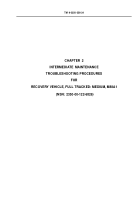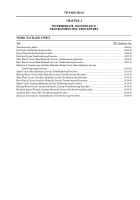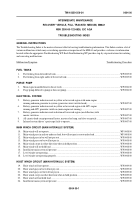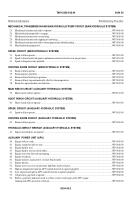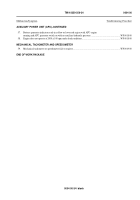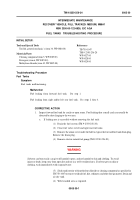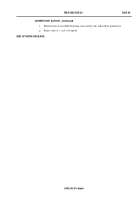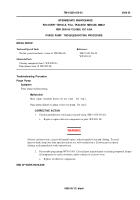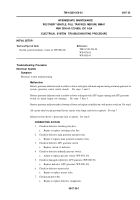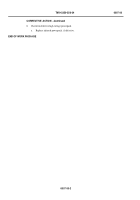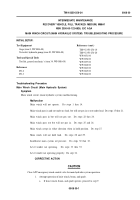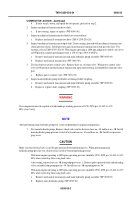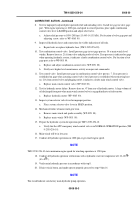TM-9-2350-256-34 - Page 74 of 584
TM 9-2350-256-34
0005 00
CORRECTIVE ACTION –Continued
(7)
Close forward fuel tank bypass valve and drain valve. Install drain plug in bottom
of tank.
(8) Install electric fuel pump (TM 9-2350-256-20).
(9)
Disconnect the fuel vent hose on top of the forward fuel tank.
(10) Connect an air hose and suitable gage to the disconnected vent opening in
the forward fuel tank, apply 3–4 psi (21–28 kPa) internal air pressure.
(11) Apply soapy water solution, consisting of liquid detergent diluted with 20–40%
water, to all exterior surfaces of tank and inspect for air bubble formation.
(12) Mark location of any bubble formation, release air pressure, rinse and dry tank, and
weld the marked area.
(13) Repeat steps (10), (11), and (12) if required.
b.
If leaking area is inaccessible with the fuel tank installed:
(1)
Drain the fuel system (TM 9-2350-256-20).
(2)
Remove the forward fuel tank from the vehicle (WP 0029 00).
(3)
Slush tank interior with methylene chloride or cleaning compound as specified in
TB 750-1047 to removeresidualfuel,dirt, sediment, and other foreign matter. Drainand
air dry tank.
(4) Inspect tank for any obvious cracks or open seams. Inspect mounting brackets,
mounts, and cushions for cracks or breaks. Weld assembly and components as required.
(5)
Close all openings with temporary plugs or other closures and apply 3–4 psi (21–28
kPa) internal air pressure.
(6)
Apply soapy water solution, consisting of liquid detergent diluted with 20–40%
water, to all exterior surfaces of tank and inspect for air bubble formation.
(7)
Mark location of any bubble formation, rinse and dry tank, and weld the marked ar-
eas.
(8)
Repeat steps (5), (6), and (7) if required.
(9)
The electric intake fuel pump and other fittings and accessories may be assembled
on the tanks either before or after installation of the tanks in the vehicle (TM 9-2350-
256-20).
2.
Remove the engine deck (TM 9-2350-256-20). Inspect fuel tank for cracks or open seams. Fuel leaking
from a small crack can usually be detected by dust clinging to the wet area.
3.
If the fuel leak cannot be detected or repaired with powerplant installed in the vehicle, remove the fuel
tank. For removal of the left rear fuel tank, refer to WP 0027 00. For removal of the right rear fuel tank,
refer to WP 0028 00.
4.
If fuel leak cannot be detected or repaired with fuel tank installed in vehicle, remove the powerpack
(TM 9-2350-256-20).
a.
Drain the fuel system (TM 9-2350-256-20).
b.
Slush tank interior with methylene chloride or cleaning compound as specified in TB 750-1047
to remove residual fuel, dirt, sediment, and other foreign matter. Drain and dry fuel tank.
c.
Inspect tank for any obvious cracks or open seams. Inspect mounting brackets, mounts, and
cushions for cracks and breaks. Weld assembly and components as required.
d.
Close all openings with temporary plugs or other closures and apply 3–4 psi (21–28 kPa) internal
air pressure.
e.
Apply soapy water solution, consisting of liquid detergent diluted with 20–40% wa-
ter, to all exterior surfaces of tank and inspect for air bubble formation.
0005 00-2
Back to Top


